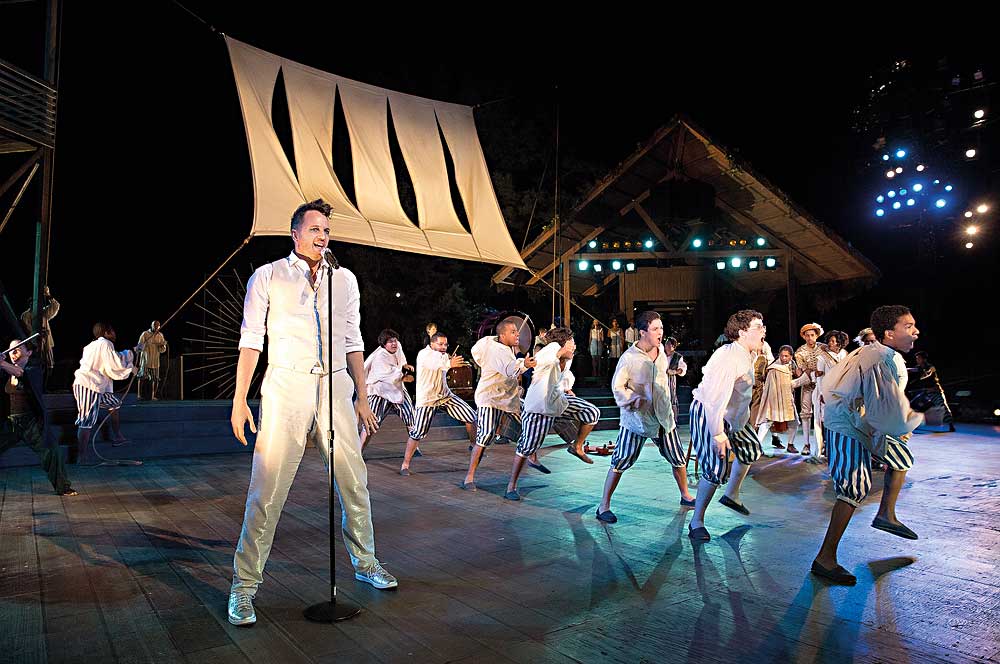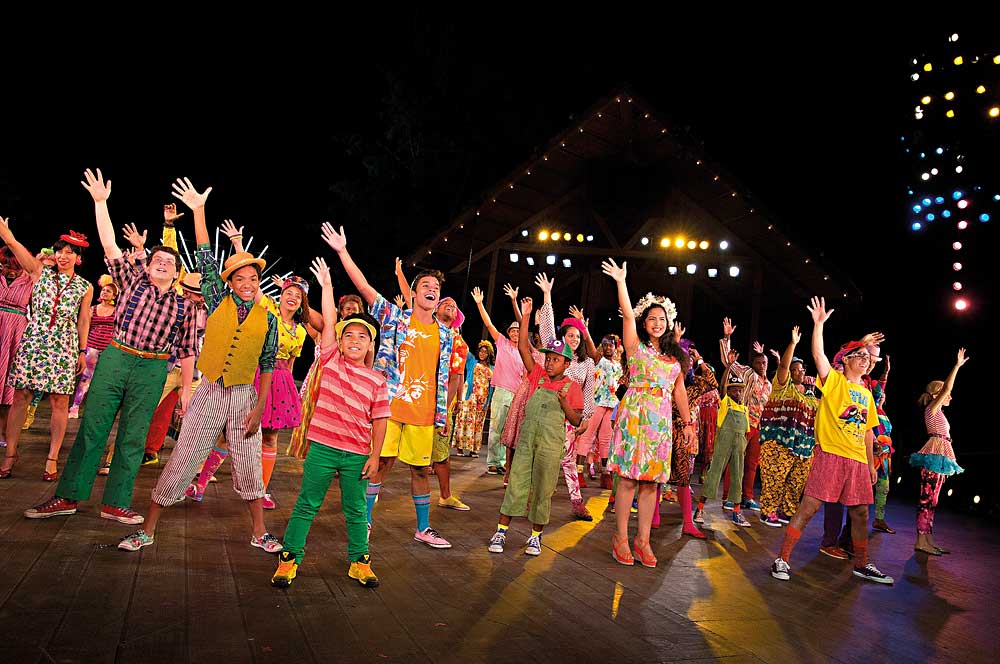
As The Tempest’s dramaturg, I had a ringside seat to deBessonet’s strategy—and it was fascinating to see how much the participants thrilled to the idea that the project had a precedent. In 1916, we learned, the progressive poet Percy MacKaye staged a mass-participation pageant at Harlem’s Lewisohn Stadium called Caliban by the Yellow Sands, a huge “community masque” that MacKaye hoped would revive the form (2,500 hundred New Yorkers took part; 15,000 thousand came). MacKaye and his fellows in the Silver Age historical pageantry movement understood the heady mix of spectacle and inclusion; they saw it as a way to build civic foundation, to tie American identity to its own landscape and the “city beautiful.” By radically increasing the number onstage, pageantry elides the line between spectator and performer.
Watching The Tempest, you felt the power dynamic changing—the usual imbalance of a few actors facing down a huge audience became something more like an exchange of equals. The production seemed to evoke a sort of ideal New York—an island “full of noises, sounds, and sweet airs that give delight and hurt not.” DeBessonet echoed MacKaye, her cultural forebear, and the Public Works community thrilled to the purpose-driven idea of the deeper event.
When MacKaye had wanted to perform his Caliban in Central Park, he was turned down, and frequently I heard Tempest cast members talking about how they were finally making that injustice right. The Public’s artistic director Oskar Eustis also sees Public Works as the logical continuation of Joseph Papp’s populist dream. “There’s tremendous external pressure to turn the theatre into this glittering object that is then purchased by the wealthy, therefore validating their cultural ‘with-it-ness.’ And that kind of commodification of the theatre is horrifying to me,” Eustis says. “It’s not what we’re here to do. What Public Works does is definitely art. It’s not just some program. These are works of theatrical art that completely break down the boundary between who is making it and who is watching it, and that return the act of making and watching and participating in theatre to a set of relationships, and not to an object.”
But don’t call it a mission. DeBessonet’s religiosity has undergone radical changes during her adulthood, and those changes help explain some of her theatrical methods and convictions. Those deep readjustments have made her reject any language that calls her work “a mission,” with all the ugly post-colonial associations that the word conjures up. She’s intent on clearing up this misunderstanding. “The ‘mission’ concept,” deBessonet protests, “doesn’t work here, because it implies that there’s just one person with the resources—one person ‘saving,’ one person giving.”
Yet Eustis suggests there is still a “spiritual”-foundation to her artistic approach: “There is a belief in the essential beauty of every individual soul and the idea that every person is infinitely valuable.”
Zeus, one of the foundation stones of the ensemble, explained their aims to a documentary crew in even grander terms: “This is our proposal to humanity.”
In these civic dramas, the work is made in partnership, rather than as a “charitable” act. DeBessonet emphasizes, “We use professional theatre actors alongside a gloriously vivid community ensemble, bringing their humanity, their honesty, their realness. It actually solves so many directorial problems for me, because they are non-actors—they couldn’t mug if you asked them to! In many ways, they’re actually ideal performers.” The cameo groups, local performers of excellence like Calpulli or the Eliot Feld Ballet Tech, add their own virtuosity. “We need these groups because they have charismatic lightning to solve our dramaturgical problems,” the director insists.
The Tempest wound up being more cohesive than The Odyssey, perhaps because the original play—itself a masque—seems to invite musical interference. Broadway stars (Laura Benanti, Norm Lewis) moved among those who had never been onstage before, including three adorable members of the New York Taxi Workers Alliance who ferried Miranda to her wedding in a big cardboard cab. Composer/lyricist/co-adaptor Almond was again our host, but Tempest afforded him the perfect tricksy, lightsome, ever-vanishing role in Ariel, Prospero’s trusty spirit of the air.
This year’s show, The Winter’s Tale, didn’t have such an obvious space for him. Even as Almond was taking on the task of writing a second musical Shakespeare adaptation in two years, he recalls asking, “Who can I play? There’s suddenly a list of criteria—I have to be able to talk to the audience, I have to be able to use contemporary language, I have to be able to disappear from the story.” Winter’s Tale has other challenges built in—it’s less frequently performed, for example, and fewer people know the story. But one thing is familiar—Shakespeare’s most famous stage direction, “Exit, pursued by a bear.”
That became the lightbulb. “Oh!” said Almond. “I’m the guy who dies! I’ll be Antigonus, and I’m dead. Then I can tell the Tale, saying, ‘Let me show you how that happened—let’s go back in time.’”
For both Almond and deBessonet, The Winter’s Tale is a story that grapples profoundly with time, with regret, with the ability to undo seemingly irrevocable actions. If Tempest was about opening a heart gripped by revenge, The Winter’s Tale is about the impossible, miraculous ability of bad fortune to turn into good. And that’s a nice optimism to hold in front of you as you head into a project as difficult, as work-intensive and as sheerly exhausting as the civic drama. The scale ought to be daunting, but Almond doesn’t even flinch. DeBessonet has her own charismatic lightning, and maybe that is the actual unifying force among her many projects.
“If I were faced with pitch darkness in front of me,” Almond says, “I would follow Lear in.” He pauses. “She sheds light as she goes.”
Helen Shaw is a New York City-based theatre critic.


